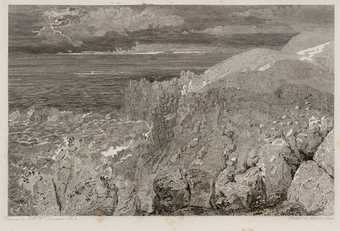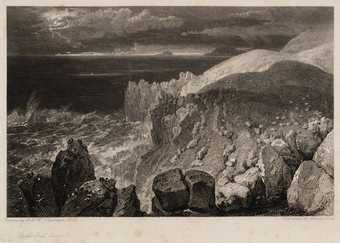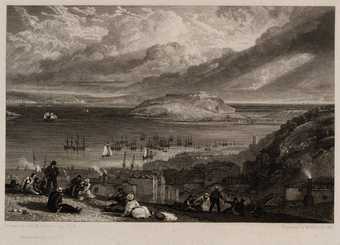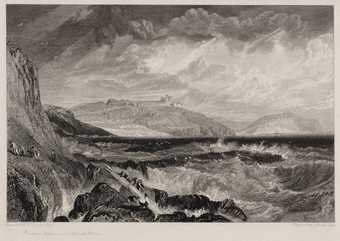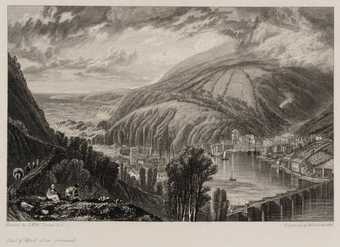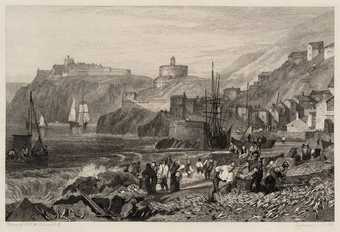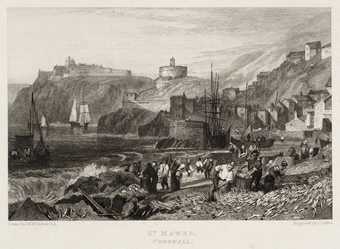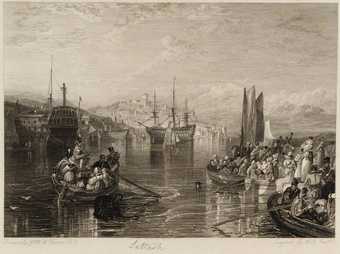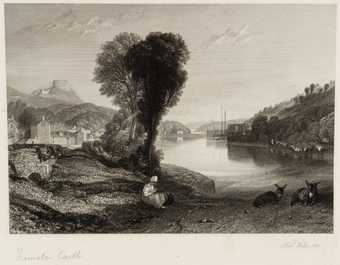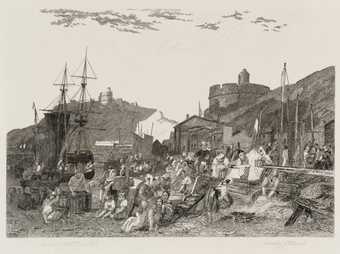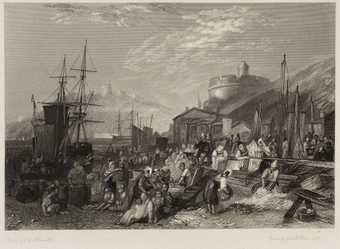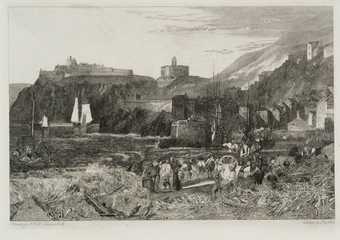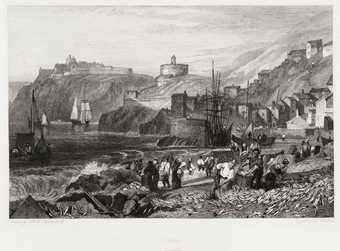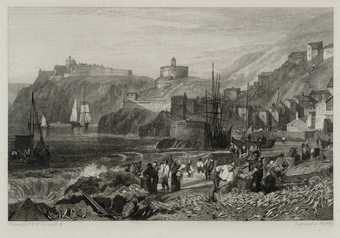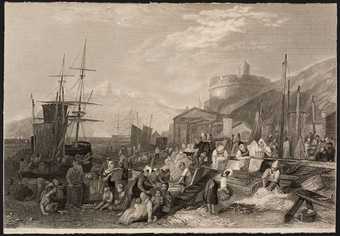
In Tate Britain
Prints and Drawings Room
View by appointment- Artists
-
After Joseph Mallord William Turner 1775–1851
James Charles Allen ?1790–1833 - Medium
- Line engraving on paper
- Dimensions
- Image: 146 × 223 mm
- Collection
- Tate
- Acquisition
- Purchased 1986
- Reference
- T04410
Display caption
Turner’s view of St Mawes shows pilchards piled up on the beach, going to waste as a result of lost access to markets in mainland Europe during the Napoleonic Wars.
Gallery label, November 2022
Does this text contain inaccurate information or language that you feel we should improve or change? We would like to hear from you.
Catalogue entry
[from] Picturesque Views on the Southern Coast of England
pub.1814–26 [T04370-T04427; complete]
Fifty-eight etchings and line-engravings, by various engravers and in various states, some touched with pencil, white chalk or brown ink, comprising thirty-five subjects out of a total of forty by Turner for this series; various papers and sizes; some annotated in pencil with names of collectors
Purchased (Grant-in-Aid) 1986
Prov:
...; N.W. Lott and H.J. Gerrish Ltd, from whom bt by Tate Gallery (earlier provenance given in individual entries where known)
Lit: A.J. Finberg, Turner's ‘Southern Coast’, 1929; Eric Shanes, Turner's Rivers, Harbours and Coasts, 1981; Andrew Wilton, Turner in his Time, 1987; Eric Shanes, Turner's England 1810–38, 1990
Picturesque Views on the Southern Coast of England was planned and produced by the engraver William Bernard Cooke (1778–1855). A pupil of William Angus, in about 1810 Cooke set up business as a publisher of prints and illustrated books, working in close collaboration with his brother and fellow-engraver George Cooke (1781–1834). The Southern Coast was probably started the following year. Rawlinson (I 1908, p.118) gives details of the subscription ‘conditions’ (according to Finberg 1929, p.xii, no copy of the original prospectus has survived) which promise that ‘after the completion of the Southern Coast, it is intended to proceed with the whole circuit of England, including that of Wales, agreeably to the original Prospectus’. Details of the publication proposals are given, together with the subscription conditions, and these appear again later on the brown paper wrappers of the serial parts. It is stated on the wrapper to the first part, issued in January 1814, that the work was to be completed in sixteen parts, and that each part would contain three full-page plates and two vignettes, with descriptive letterpress for each view.
Thus it was anticipated to publish a total of eighty plates, of which forty-eight were to be full-page, and thirty-two vignettes, and this was in fact the actual number issued (although subsequent part wrappers up to - and including - part XII stated that the work would contain fifty full-page plates and thirty vignettes, see Finberg 1929, p.xi). The parts were issued at three different prices: 12s. 6d. for Royal Quarto on Whatman; 18s. for Imperial Quarto on Whatman; and £1. 10s. for Imperial Quarto on India paper.
Turner was originally contracted for twenty-four drawings at £7. 10s. each, but his fee was increased to ten guineas in 1815 after the first four parts had been issued. And eventually he provided forty subjects for the project, thirty-nine of which were engraved as full-page plates from watercolours provided by him specially for the purpose; one, ‘Martello Towers at Bexhill’, was engraved as a vignette probably from the same design as that Turner had already used for a plate in the Liber Studiorum (see under T 04392). The drawings for the remaining nine full-page plates were provided by Joshua Cristall, Henry Edridge, William Alexander, Samuel Owen, William Havell, William Westall and Peter de Wint; whilst the remainder of the vignettes were supplied by William Collins, Edward Blore, Luke Clennell, James Hakewill, Louis Francia and Samuel Prout, as well as by some of those artists who had also contributed designs for the larger plates.
Originally it was intended that all eighty designs would be engraved by the Cooke brothers themselves, and that the different parts would appear at intervals of three months. Had this plan been followed, the project would have been completed by December 1817, but in the event only half of the sixteen parts had appeared by that date; in a letter of 3 June 1819, W.B. Cooke admitted to Turner that he had perhaps had ‘too great confidence’ in his ‘own powers as to time’ (see Gage 1980, no.82). Towards the end of the project, therefore, other engravers were taken on to speed up publication: between 1824 and 1826, when the last four parts were issued, the names of Edward Goodall (1795–1870), J.C. Allen (active 1821–31), Richard Wallis (1794–1878), William Miller (1796–1882), William Radclyffe (1783–1855) and John Horsburgh (1791–1869) appear on the plates (for details of the individual parts, see Finberg 1929, Appendix B, pp.76–8). The accompanying letterpress to the series was written by William Combe, better known as the author of Doctor Syntax, although the engraver John Landseer (1769–1852) and Turner himself had both been previously considered as contributors (Turner's draft verse for the project is discussed by Andrew Wilton, Painting and Poetry: Turner's ‘Verse Book’ and his Work of 1804–1812, exh. cat., Tate Gallery 1990, under no.57, and pp.170–6).
W.B. Cooke himself put up the entire initial capital for the Southern Coast and formed a syndicate with the publisher John Murray (1778–1843), who was chief shareholder and responsible for advertising and distributing the work (Shanes 1990, p.9 and n.3). Murray acted as publisher until shortly after part X appeared in 1820, but from part XI (pub. 1821) was replaced by the Quaker booksellers and publishers John and Arthur Arch of Cornhill, London (Herrmann 1990, pp.84–5, mistakenly records the change of publisher taking place between parts XI and XII). The change of publisher was not due, it would appear, to financial problems; Herrmann draws attention to a number of letters preserved in the John Murray archives which indicate how successful the series was from an early date (in a letter of 1814, for example, Cooke comments on the fact the part IV had sold out, see Herrmann 1990, p.85). Rather, a rupture arose between Cooke and Murray over another series the former was engraving during the same period, Views in Sussex (see T04428-T04438 and T05078); because the first part of this work was not ready by the agreed time, Murray refused to advertise it in the list of his publications issued in one of the numbers of his Quarterly Review for 1819. Cooke's anger at Murray's so-called ‘deviation from all Principles of honesty or justice’ is recorded in a letter from him to Turner of 3 June 1819 (Gage 1980, no.82).
Shortly after the sixteenth and final part of the Southern Coast was published in 1826, a more serious disagreement arose between W.B. Cooke and Turner over the terms for a projected sequel. An angry letter from Cooke to Turner, dated 1 January 1827, makes clear the areas of dispute (see Finberg 1929, Appendix A and Gage 1980, pp.104–6, no.121). Turner had asked to be paid twelve and a half guineas for any ‘drawings for the future “Coast”’, further insisting, so it would seem, that the two and a half guinea increase in his fee be applied retrospectively to include some of the watercolours he had recently made for the Southern Coast as well; he also demanded ‘twenty-five sets of India proofs before the letters’. If his terms were not met, he threatened to bring out the sequel himself. This letter has often been cited as evidence of Turner's mean and grasping nature, and as a prime example of the poor relations he suffered with his engravers. Herrmann (1990, p.90), however, sides with Finberg in condemning Cooke as the ‘villain of the piece’, not only on the grounds of the engraver's exciteable temperament but also, more specifically, because Cooke had only recently made a seven guinea profit on the sale of Turner's drawing of ‘Whitstable’, just three months after the publication of the plate (see T04425-T04427). Whoever was most at fault in the dispute, there can be no doubting the damage it caused to their relationship. Two other projects on which Cooke and Turner were collaborating in 1827, The Rivers of England and Marine Views (see T04790-T04819, T04917 and T04820), both foundered as a result of the bitter argument, and the two men were not to work together again.
However, the Southern Coast seems to have proved a financial and critical success (see Herrmann 1990, p.90). We know for example - from the same letter of 1 January 1827 from Cooke to Turner - that Turner as one of the shareholders in the scheme had by that date been paid ‘a constant dividend of profit... at various times’ and would continue to be so rewarded ‘for some time to come’. In 1826 all eighty plates were arranged geographically from Kent to Somerset, bound in two volumes and published by J. and A. Arch (a copy with two volumes bound as one is in the Turner study room library at the Tate Gallery). Rawlinson (I 1908, pp.46–7) lists four subsequent reprints, but these are corrected by Finberg (1929, p.ix) to three: that of 1849 by Nattali of Bond Street, the re-issue in the ‘Turner Gallery’ of 1874, and the 1891 reprint by Virtue and Company under the direction of Marcus Huish (Rawlinson's reprints A, C and D respectively). Finberg's 1929 catalogue of the Southern Coast follows the sequence used by Rawlinson, where the plates are given in order of publication. However, Finberg gives a more accurate publishing history for the various states, and thus his catalogue has been followed here. The original publication date and part number of each print is given first, and then its volume and plate number in the 1826 reissue is given in brackets.
Many touched proofs are known to have survived for this series, a number of which are included in the sequence catalogued below (there are many more touched proofs in the famous ‘Tweedmouth’ collection of Southern Coast proofs acquired by the Tate Gallery in 1988, which will be catalogued at a future date). Some of the impressions are presentation proofs from W.B. Cooke or George Cooke, often to a ‘Mr W. Loddize’ (see T04385-T04386 and T04421). Other collectors mentioned in the provenance are Henry Studdy Theobald (1847–1934; Lugt 1376 and supplement), Herbert Percy Horne (1864–1916; Lugt 1266 c), Guy Bellingham Smith (1865–1945; probably identifiable with Lugt 1140, see under T04485-T04501 below) and H.G. Barnard.
T04410 St Mawes, Cornwall engr. J.C. Allen
Line-engraving 145 × 222 (5 11/16 × 8 3/4) on wove paper 296 × 446 (11 5/8 × 17 1/2); plate-mark 228 × 305 (8 15/16 × 12); watermark ‘J WHATMAN | TURKEY MI[LL]’ (see Edward Heawood, Watermarks, 1950, no.3464)
Inscribed, presumably by W.B. Cooke, ‘WBC’ below plate-mark. Engraved inscriptions as on T 04409 but with title ‘,, S [semi-erased],, St Mawes,, | Cornwall,,’ added at centre below
Prov: ? W.B. Cooke; then as for T04372
Lit: As for T04409 but Finberg engraver's proof 2
Published in:
Tate Gallery: Illustrated Catalogue of Acquisitions 1986-88, London 1996
Explore
- architecture(30,960)
- townscapes / man-made features(21,603)
-
- townscape, distant(8,109)
- group(4,227)
- Cornwall(1,034)
- England(19,202)
- England, South West(3,507)
- England, Southern(8,982)
- transport: water(8,015)
-
- ship, sailing(1,342)
- agriculture and fishing(1,275)
You might like
-
After Joseph Mallord William Turner Land’s End, Cornwall
1814 -
After Joseph Mallord William Turner Land’s End, Cornwall
1814 -
After Joseph Mallord William Turner Falmouth Harbour, Cornwall
1816 -
After Joseph Mallord William Turner Pendennis Castle and Entrance of Falmouth Harbour, Cornwall
1817 -
After Joseph Mallord William Turner East and West Looe, Cornwall
1818 -
After Joseph Mallord William Turner St Mawes, Cornwall
1824 -
After Joseph Mallord William Turner St Mawes, Cornwall
1824 -
After Joseph Mallord William Turner Saltash, Cornwall
1827 -
After Joseph Mallord William Turner Trematon Castle, Cornwall
1830 -
After Joseph Mallord William Turner St Mawes, Cornwall
1830 -
After Joseph Mallord William Turner St Mawes, Cornwall
1830 -
After Joseph Mallord William Turner St Mawes
1824 -
After Joseph Mallord William Turner St Mawes
1824 -
After Joseph Mallord William Turner St Mawes
1817 -
After Joseph Mallord William Turner St Mawes, Cornwall, engraved by J.H. Kernot
published 1830

